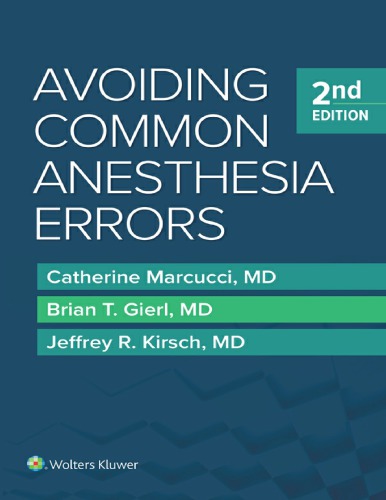Avoiding Common Anesthesia Errors 2nd Edition by Catherine Marcucci, Brian Gierl, Jeffrey Kirsch ISBN 1496355180 9781496355188
$50.00 Original price was: $50.00.$35.00Current price is: $35.00.
Avoiding Common Anesthesia Errors 2nd Edition by Catherine Marcucci, Brian T. Gierl, Jeffrey R. Kirsch – Ebook PDF Instant Download/Delivery: 1496355180, 9781496355188
Full download Avoiding Common Anesthesia Errors 2nd Edition after payment
Product details:
ISBN 10: 1496355180
ISBN 13: 9781496355188
Author: Catherine Marcucci, Brian T. Gierl, Jeffrey R. Kirsch
Avoiding Common Anesthesia Errors 2nd Edition: Selected as a Doody’s Core Title for 2022 and 2023!
The full-color Avoiding Common Anesthesia Errors, significantly updated for this second edition, combines patient safety information and evidence-based guidance for over 300 commonly encountered clinical situations. With a format that suggests conversations between an attending and a trainee, the book helps you identify potential problems and develop a treatment plan to minimize the problem. Brief, easy-to-read chapters cover basic and advanced topics and help you digest information in minutes!
- Coverage spans the entire field of Anesthesiology—including subspecialties such as airway management, critical care and pain medicine.
- Now with 30% more topics than the first edition.
- Contributors now include more international authors and Certified Nurse Anesthetists (CRNAs).
- Features critical updates to popular chapters and sections related to legal issues, professional practice topics and coding and payment.
- Part of the Avoiding Common Errors series, which presents hard-earned clinical wisdom in an informal, easy-to-read style.
Enrich Your Ebook Reading Experience
- Read directly on your preferred device(s), such as computer, tablet, or smartphone.
- Easily convert to audiobook, powering your content with natural language text-to-speech.
Avoiding Common Anesthesia Errors 2nd Edition Table of contents:
AIRWAY AND VENTILATION
- Basics
- Never neglect the basics of airway management.
- Basics of airway management – Part II (Tips and Tidbits).
- Consider PEEP.
- Advanced
- A variety of techniques provide acceptable anesthesia for awake intubation of the airway: ultimately, the most important factors are operator experience and adequate time.
- Special Cases
- A high inspired concentration of oxygen is contraindicated in certain circumstances.
- Remember that there are special considerations involved with both intubation and chronic airway management of burn patients.
- Problem Solving
- Always troubleshoot an increase in peak airway pressure.
- Plan for an airway fire with every head and neck case.
- Know how to perform a cricothyroidotomy.
- Perioperative Issues
- Don’ts
- Do not overinflate the cuff of the endotracheal tube.
- Don’t underrepresent the risks associated with the use of a laryngeal mask airway.
- Do not be intimidated by the placement and use of double-lumen endotracheal tubes.
- Do not underestimate the difficulty of reintubating a patient who has undergone carotid endarterectomy or cervical spine surgery.
- Do not start the airway management of a Ludwig angina patient until personnel and equipment for a definitive (surgical) airway are assembled.
- Don’ts
LINES AND ACCESS
- Basics
- Remember that the IV start is your first chance to make a favorable impression on the patient.
- Never use an intravenous line without palpating and inspecting it visually.
- Use of ultrasound guidance for cannulation of the central veins improves success rates, decreases the number of attempts, and lowers complication rates.
- Central Lines
- Central line placement: never neglect the basics.
- Approach the use of a pulmonary artery catheter with caution.
- Avoid technique-related central venous catheter complications by using modern tools.
- Don’ts
- Don’t overflush lines.
- Do not use the subclavian vein for central access of any type in a patient planned for dialysis.
- Errors
- Remember that inadvertent intra-arterial injection is not rare.
- Avoid errors in invasive blood pressure measurement.
- Remember that loss of a patent hemodialysis fistula in the perioperative period is a serious event for the patient and requires immediate communication with the surgeons.
FLUIDS, RESUSCITATION, AND TRANSFUSION
- Fluids
- Hypertonic saline: the “solution” to the solution problem?
- Remember that the synthetic colloid solutions have distinct properties and risk/benefit ratios.
- Resuscitation
- Protect the kidneys, not the “UOP.”
- Do not treat lactic acidosis with bicarbonate.
- Consider the use of tris-hydroxymethyl aminomethane (THAM) to treat refractory or life-threatening metabolic acidosis.
- Use the principles of “damage control anesthesia” in the care of the massively bleeding patient and ask the surgeons to implement “damage control surgery” if necessary.
- Learn from the care of the combat victim: ask the surgeons to consider damage control surgery for the bleeding patient.
- Transfusion
- Know what screening tests are performed on volunteer donor blood.
- Transfusion of packed red blood cells requires a careful risk-benefit analysis.
MEDICATIONS
- Perioperative Issues
INTRAOPERATIVE AND PERIOPERATIVE
- Basics
REGIONAL ANESTHESIA
PACU
PEDIATRIC ANESTHESIA
NEUROANESTHESIA
CARDIAC ANESTHESIA
OB ANESTHESIA
PAIN MEDICINE
HUMAN FACTORS
LEGAL
PROFESSIONAL PRACTICE
CODING AND PAYMENT
- Make sure you get paid.
COMMENCEMENT
People also search for Avoiding Common Anesthesia Errors 2nd Edition:
how to prevent anesthesia complications
how to prevent anesthesia awareness
avoiding common errors in the emergency department
avoiding common errors in the emergency department pdf
anesthesia errors statistics
Tags:
Catherine Marcucci,Brian Gierl,Jeffrey Kirsch,Avoiding,Common,Anesthesia,Errors



